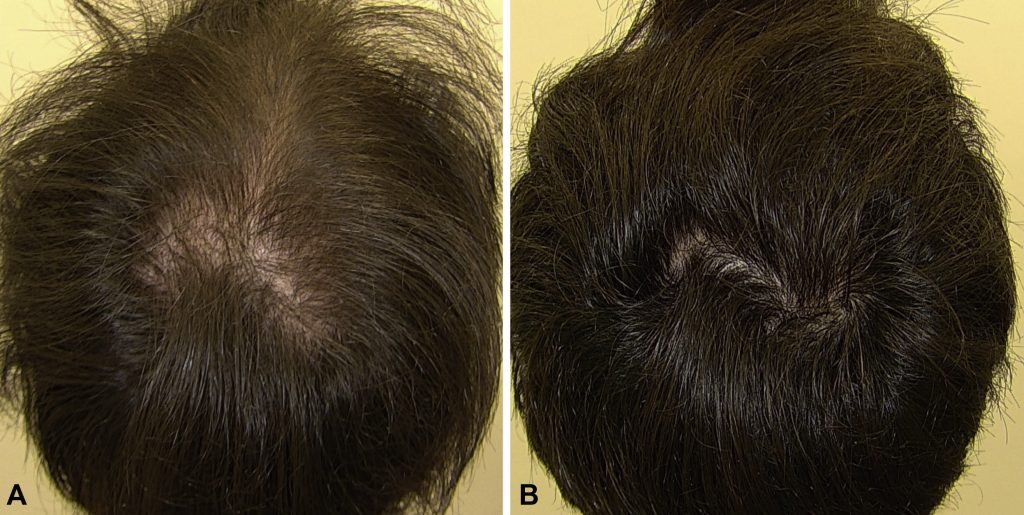Minoxidil for hair is one of the common products for people who suffer from hair thinning and hereditary baldness Minoxidil is available in the form of a foam or a spray. It comes in two concentrations, a concentration of 2% for women and a concentration of 5% for men. It has many trade names, and it helps to stop hair loss and stimulate new growth, and in This article will explain to you its benefits and harms.
Minoxidil:
Minoxidil was originally used as a vasodilator, and it was used as tablets for people who suffer from high blood pressure levels, in 1960 and after a period of regular use of minoxidil tablets, some side effects began to appear on its users, most notably excessive hair growth in the body, as they noted Its users increase the density of their hair, and that their hair loss decreases. Scientists have come to use the solution topically to treat hair loss and to treat localized baldness.
How Minoxidil works to stimulate hair growth:
Scientists do not agree on how minoxidil works to promote hair growth, and board-certified dermatologist “Diva Schocken” explained that hair growth is likely to occur because minoxidil causes increased blood flow to the hair by expanding blood vessels in the scalp. As some research has proven, minoxidil increases a certain enzyme called ATP in hair follicles, which leads to prolonging their sleep phase, and this phase is scientifically called the anagen phase.
Benefits of minoxidil for hair:
1Stimulating hair growth:
Regular use of Minoxidil stimulates hair growth, but each person is different from the other, so results may vary, but in general in about 60 to 70 percent of people, hair density will generally begin to stabilize after two to three months of treatment, and after about Six to eight months, the intensity will begin to occur in 40-50% of patients.
2Increases hair thickness and density:
It thickens your hair so strands grow back fuller and healthier, and works to quell a receding hairline making your hair look fuller.
3Suitable for most hair types:
It is safe for all hair types, including natural hair, although people with colored and dyed hair may experience more scalp irritation, and is less effective for certain types of hair loss, such as the more common forms of cicatricial alopecia in women. blacks.
What is alopecia disease ? And how it can be treated
4Minoxidil and hair growth cycle:
Hair follicles go through four stages of growth, not every follicle is in the same stage at once. Scientists believe that minoxidil affects two stages of hair growth:
5Growth stage:
Known as the anagen phase, this occurs when the hair is pushed out from the roots, and the application of minoxidil may prolong the anagen phase.
6Telogen phase (resting phase):
The resting phase means the time of hair loss, when it has finished growing but is not ready to fall out yet. In clinical trials, minoxidil shortened the hair telogen phase from 20 days to just one or two days.

Common side effects of minoxidil use:
Vitamins for hair loss will benefit you very much
- irritation
- eczema
- Abnormal hair growth on the body
- Allergic contact dermatitis
- Redness at the site of application of minoxidil solution or foam
- Exacerbation of hair loss
- Respiratory infections
- tendinitis
- Back ache
- Sinusitis
- fluid retention in the body (edema)
- Worried
- Reduction of Blood pressure
- dizziness
- Vertigo
- feel helpless
Warnings and precautions for the use of topical minoxidil:
Watch the best ways to speed up hair growth
- Hypersensitivity to minoxidil or the components of the drug, as it may cause side effects and serious complications.
- Caution should be exercised when using in patients with heart disease.
- The solution is flammable, it should be kept away from fire, flame or high heat.
- Do not use when there is an infection, redness or inflammation.
- Avoid contact with the eyes, as it may cause irritation and redness of the eyes.
Use of minoxidil during pregnancy and lactation:
Minoxidil should be avoided during pregnancy and breastfeeding, as it may cause complications for the fetus.
What causes hair loss with the use of minoxidil?
Usually the side effects are mild, and the common side effects include mild itching, burning, peeling of the skin and dandruff and it may also cause hair loss when you first start using it, because minoxidil speeds up the resting phase of your hair, it sometimes falls out more quickly than usual.
However, minoxidil also prolongs the hair growth phase, meaning that although some of your hair is initially expected to fall out, the new growth will soon replace what you’ve lost.
However, not everyone will experience hair loss as a side effect, while some may experience severe hair loss.
Can you prevent hair loss associated with the use of minoxidil?
There is not much you can do to prevent the hair loss associated with minoxidil, and you should keep in mind that the higher the concentration of minoxidil the stronger the side effects, if you are noticing a lot of hair loss then you should use a lower strong dose.
Cons of using minoxidil:
If you stop using minoxidil, it may cause new hair loss to start in a fast way, so if you decide to use minoxidil to treat androgenetic alopecia or to stop hair loss you must continue minoxidil for life to maintain the results you have.
If you are concerned about hair loss and have not started using it yet, start with a lower concentration (2%) and then use a higher concentration (5%) if you need it, and you should not suddenly stop using it after a period of use to avoid new hair loss

